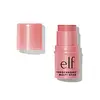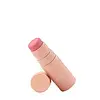What's inside
What's inside
 Key Ingredients
Key Ingredients

 Benefits
Benefits

 Concerns
Concerns

 Ingredients Side-by-side
Ingredients Side-by-side

Polymethyl Methacrylate
Triethylhexanoin
MaskingDimethicone
EmollientCetyl Ethylhexanoate
EmollientSynthetic Fluorphlogopite
Mica
Cosmetic ColorantHydrogenated Polydecene
EmollientButyrospermum Parkii Butter
Skin ConditioningPolyethylene
AbrasiveIsononyl Isononanoate
EmollientC10-18 Triglycerides
EmollientMicrocrystalline Wax
Emulsion StabilisingEuphorbia Cerifera Wax
Sorbitan Sesquiisostearate
EmulsifyingCaesalpinia Sappan Bark Extract
Skin ConditioningPhenoxyethanol
PreservativeCaprylyl Glycol
EmollientTocopheryl Acetate
AntioxidantTin Oxide
AbrasivePolymethyl Methacrylate, Triethylhexanoin, Dimethicone, Cetyl Ethylhexanoate, Synthetic Fluorphlogopite, Mica, Hydrogenated Polydecene, Butyrospermum Parkii Butter, Polyethylene, Isononyl Isononanoate, C10-18 Triglycerides, Microcrystalline Wax, Euphorbia Cerifera Wax, Sorbitan Sesquiisostearate, Caesalpinia Sappan Bark Extract, Phenoxyethanol, Caprylyl Glycol, Tocopheryl Acetate, Tin Oxide
Polymethyl Methacrylate
Triethylhexanoin
MaskingDimethicone
EmollientMica
Cosmetic ColorantHydrogenated Poly(C6-14 Olefin)
EmollientCetyl Ethylhexanoate
EmollientPolyethylene
AbrasiveSorbitan Sesquiisostearate
EmulsifyingMicrocrystalline Wax
Emulsion StabilisingEuphorbia Cerifera Wax
Squalane
EmollientC10-30 Cholesterol/Lanosterol Esters
EmulsifyingStearalkonium Hectorite
Gel FormingTocopheryl Acetate
AntioxidantCaprylyl Glycol
EmollientMethicone
EmollientGlyceryl Caprylate
EmollientHexylene Glycol
EmulsifyingPhenoxyethanol
PreservativeTitanium Dioxide
Cosmetic ColorantIron Oxides
CI 15850
Cosmetic ColorantPolymethyl Methacrylate, Triethylhexanoin, Dimethicone, Mica, Hydrogenated Poly(C6-14 Olefin), Cetyl Ethylhexanoate, Polyethylene, Sorbitan Sesquiisostearate, Microcrystalline Wax, Euphorbia Cerifera Wax, Squalane, C10-30 Cholesterol/Lanosterol Esters, Stearalkonium Hectorite, Tocopheryl Acetate, Caprylyl Glycol, Methicone, Glyceryl Caprylate, Hexylene Glycol, Phenoxyethanol, Titanium Dioxide, Iron Oxides, CI 15850
 Reviews
Reviews

Ingredients Explained
These ingredients are found in both products.
Ingredients higher up in an ingredient list are typically present in a larger amount.
Caprylyl Glycol is a humectant and emollient, meaning it attracts and preserves moisture.
It is a common ingredient in many products, especially those designed to hydrate skin. The primary benefits are retaining moisture, skin softening, and promoting a healthy skin barrier.
Though Caprylyl Glycol is an alcohol derived from fatty acids, it is not the kind that can dry out skin.
This ingredient is also used as a preservative to extend the life of products. It has slight antimicrobial properties.
Learn more about Caprylyl GlycolCetyl Ethylhexanoate is an emollient ester. It comes from cetearyl alcohol and 2-ethylhexanoic acid.
Cetyl Ethylhexanoate is an emollient that adds a velvety feel to skin without being greasy or oily. Emollients help trap moisture into your skin, keeping your skin soft and hydrated.
Dimethicone is a type of synthetic silicone created from natural materials such as quartz.
What it does:
Dimethicone comes in different viscosities:
Depending on the viscosity, dimethicone has different properties.
Ingredients lists don't always show which type is used, so we recommend reaching out to the brand if you have questions about the viscosity.
This ingredient is unlikely to cause irritation because it does not get absorbed into skin. However, people with silicone allergies should be careful about using this ingredient.
Note: Dimethicone may contribute to pilling. This is because it is not oil or water soluble, so pilling may occur when layered with products. When mixed with heavy oils in a formula, the outcome is also quite greasy.
Learn more about DimethiconeMica is a naturally occurring mineral used to add shimmer and color in cosmetics. It can also help improve the texture of a product or give it an opaque, white/silver color.
Serecite is the name for very fine but ragged grains of mica.
This ingredient is often coated with metal oxides like titanium dioxide. Trace amounts of heavy metals may be found in mica, but these metals are not harmful in our personal products.
Mica has been used since prehistoric times throughout the world. Ancient Egyptian, Indian, Greek, Roman, Aztec, and Chinese civilizations have used mica.
Learn more about MicaMicrocrystalline Wax is created by de-oiling petroleum. It is highly refined and purified before being added to cosmetics.
Microcrystalline Wax is used to enhance the texture and create even consistency. It helps stabilize a product by preventing ingredients from separating.
Phenoxyethanol is a preservative that has germicide, antimicrobial, and aromatic properties. Studies show that phenoxyethanol can prevent microbial growth. By itself, it has a scent that is similar to that of a rose.
It's often used in formulations along with Caprylyl Glycol to preserve the shelf life of products.
Polyethylene is a synthetic ingredient that helps the skin retain moisture. It is a polymer.
It is also typically used within product formulations to help bind solid ingredients together and thicken oil-based ingredients. When added to balms and emulsions, it helps increase the melting point temperature.
This ingredient is also known as PMMA. It is a polymer microsphere, composed of tiny, perfectly spherical particles formed from repeating units.
In cosmetics, PMMA is mainly used to give a soft or blurring effect. The transparent particles are able to scatter light and help reduce the appearance of fine-lines and imperfections.
PMMA is also able to enhance the texture of products by add a smooth feel.
Learn more about Polymethyl MethacrylateSorbitan Sesquiisostearate isn't fungal acne safe.
Tocopheryl Acetate is AKA Vitamin E. It is an antioxidant and protects your skin from free radicals. Free radicals damage the skin by breaking down collagen.
One study found using Tocopheryl Acetate with Vitamin C decreased the number of sunburned cells.
Tocopheryl Acetate is commonly found in both skincare and dietary supplements.
Learn more about Tocopheryl AcetateTriethylhexanoin is created from glycerin and 2-ethylhexanoic acid. It is a solvent and emollient.
As a solvent, Triethylhexanoin helps dissolve ingredients to stable bases or help evenly distribute ingredients throughout the product.
It is also an emollient and helps condition the skin.
Learn more about TriethylhexanoinEuphorbia Cerifera wax comes from a shrub in Northern Mexico. It is used to stabilize formulations and has emollient properties.
Emollients form a thin layer on top of skin to prevent water from evaporating, keeping skin and lips hydrated.
According to a manufacturer, this wax can range from a yellow/brown color to translucent.
Learn more about Euphorbia Cerifera Wax